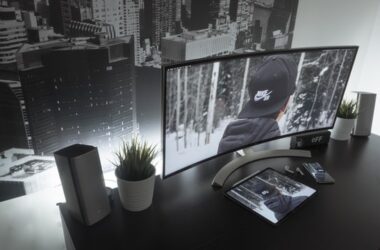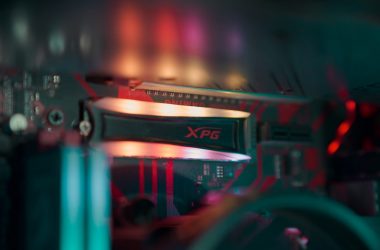OLED monitors offer the best image quality among display screens. While LED and LCD screens generate fantastic picture quality, it is no match for the far superior contrast ratios of OLED screens. Even with improvements like Quantum Dot LED (QLED) and Samsung’s Neo QLED, LED screens remain a step behind OLED, if not more.
The reason why OLED screens offer an unmatched contrast ratio has to do with how it illuminates pixels. Each pixel on an OLED display can be turned on or off individually, so you see it as a True Black when the pixel is off. And since the contrast ratio is the ratio of the darkest and brightest pixels, the contrast ratios of OLED screens are what they are.
In comparison, LCD and LED displays have a common backlight that illuminates the entire screen. And individual pixels only control the intensity of the light they allow to pass through and the color that needs to be displayed. But this mechanism only shows a dark grey instead of a deep black, resulting in a mediocre contrast ratio, and the image quality is not as good as OLED screens.
Newer LCD and LED displays use local dimming, a mechanism that reduces the backlight’s intensity for darker parts of the screen. This helps generate deeper blacks and significantly better picture quality, but still not as good as an OLED panel display.
OLED panels are often criticized for image retention and burn-ins. However, these issues are outdated and unfounded, especially with newer OLED panels. Moreover, this issue may only arise when viewing static images for a prolonged period. But OLED monitors are expensive, and with only a handful of devices on the market, not everyone can afford one.
Nevertheless, if the price is not a concern, you must consider an OLED monitor for its spectacular display.
For this, we have rounded up the best OLED monitors on the market, and we’ll review each in this article. In our buying guide, we list the key parameters to consider when buying an OLED monitor. And our FAQ section will answer any questions regarding these devices.
Table of Contents
Comparison of the Best OLED Monitor
| Image | Product | Details | Check Price |
|---|---|---|---|
 | LG 48GQ900-B | Size: 48-inch Resolution: 3840x2160 Aspect Ratio: 16:9 Refresh Rate: 120Hz VRR: G-Sync and FreeSync Premium HDR: HDR10 Ports: 3 x HDMI v.2.1 1 x DisplayPort v.1.4 2 x USB-A 3.0 1 x USB-B 3.0 1 x SPDIF 1 x 3.5mm Audio Jack | Check on Amazon |
 | AORUS FO48U | Size: 48-inch Resolution: 3840x2160 Aspect Ratio: 16:9 Refresh Rate: 120Hz VRR: FreeSync Premium HDR: HDR10 Ports: 3 x HDMI v.2.1 1 x DisplayPort v.1.4 1 x USB-C 2 x USB-A 3.0 1 x 3.5mm Audio Jack | Check on Amazon |
 | ASUS ROG Swift OLED Gaming Monitor (PG42UQ) | Size: 41.5-inch Resolution: 3840x2160 Aspect Ratio: 16:9 Refresh Rate: 138Hz VRR: G-Sync HDR: HDR10 Ports: 2 x HDMI v.2.1 2 x HDMI v.2.0 1 x DisplayPort v.1.4 1 x USB-B 3.0 4 x USB-A 3.2 Gen 2 1 x SPDIF 1 x 3.5mm Audio Jack | Check on Amazon |
 | LG 32EP950-B | Size: 32-inch Resolution: 3840x2160 Aspect Ratio: 16:9 Refresh Rate: 60Hz VRR: None HDR: DisplayHDR 400 True Black Ports: 1 x HDMI v.2.0 2 x DisplayPort v.1.4 1 x USB-B 3.0 1 x USB-C 3.0 3 x USB-A 3.0 1 x 3.5mm Audio Jack | Check on Amazon |
 | ASUS ProArt PQ22UC | Size: 21.6-inch Resolution: 3840x2160 Aspect Ratio: 16:9 Refresh Rate: 60Hz VRR: None HDR: HDR10 Ports: 1 x Micro HDMI 2 x USB-C | Check on Amazon |
 | Alienware AW5520QF | Size: 54.6-inch Resolution: 3840x2160 Aspect Ratio: 16:9 Refresh Rate: 120Hz VRR: FreeSync HDR: HDR10 Ports: 2 x HDMI v.2.0 1 x DisplayPort v.1.4 1 x USB-B 3.0 4 x USB-A 3.0 1 x SPDIF 1 x 3.5mm Audio Jack | Check on Amazon |
 | INNOCN Portable OLED Touchscreen Monitor | Size: 15.6-inch Resolution: 3840x2160 Aspect Ratio: 16:9 Refresh Rate: 60Hz VRR: None HDR: No Ports: 1 x Mini HDMI 2 x USB-C | Check on Amazon |
Best OLED Monitors – Our Pick
1. LG 48GQ900-B – Best OLED Gaming Monitor
The LG 48GQ900-B has a 48-inch OLED display panel that offers a 4K 3840x2160pixel resolution, delivering incredibly sharp images. It supports HDR 10 and provides a wide color gamut that covers 99% of the DCI-P3 color gamut. Thus, you get near-perfect color accuracy which helps provide realistic gaming visuals and offer that immersive experience that gamers seek.
The 0.1ms GtG response time, 120Hz refresh rate, and support for VRR technologies like G-Sync and FreeSync Premium ensure no distortions. Further, LG includes a Black Stabilizer, Dynamic Action Sync, and Crosshair to give you an edge over opponents while playing competitive eSports.
The monitor offers a great selection of ports that inched HDMI 2.1 and DisplayPort 1.4 ports for easy connectivity with the latest gaming consoles. It also includes dual 20W speakers, which help deliver phenomenal sound quality without the need for connecting external speakers.
The monitor has an unconventional design and doesn’t come with an ergonomic stand. So, you’ll have to try positioning it just right.
Our TakeThe LG 48GQ900-B is the best gaming OLED monitor as it combines a large 4K screen with loads of gaming features that deliver superior performance. These include a high refresh rate, low response time, VRR technologies, and whatnot. It is compatible with all the latest gaming consoles and provides you with enough ports to connect all your peripheral devices.
- The 4K display provides excellent image clarity.
- The 120Hz refresh rate and VRR technologies prevent motion blur and image tearing.
- The 0.1ms response time prevents ghosting.
- The 99% DCI-P3 color gamut ensures realistic colors.
- In-built dual 20W speakers.
- Low brightness levels don’t do justice to HDR content.
- No ergonomic stand is included with the monitor.
2. AORUS FO48U – OLED Monitor with HDMI 2.1 and USB-C Ports
The Aorus FO48U is an excellent monitor that offers top-notch specifications and combines that with the latest set of ports.
The monitor has a 48-inch 4K OLED screen with a 3840x2160pixel resolution and a 16:9 aspect ratio for a perfect widescreen experience. The OLED panel gives it a super-high contrast ratio of 135000:1, which ensures that the color looks distinct and vibrant. The 10-bit color depth delivers 1.07 billion colors that cover 98% of the DCI-P3 and 130% of the sRGB color space.
Aorus ensures that you get good HDR compatibility by including support for HDR 10, which pairs well with a peak brightness of up to 900nits. So, not only do you get a sharp image, but Aorus ensures that the image has extraordinary colors and brightness levels that make the scene look incredibly realistic.
The FO48U has plenty of features for gaming enthusiasts, which include a refresh rate of 120Hz and support for AMD FreeSync Premium to prevent motion blur and image tearing. You also get a response time of 1ms GtG, which is slower than some OLED monitors but still fast enough to prevent ghosting. What’s more, with an Air Stabilizer and Crosshair, you’ll shoot up all the bad guys, even those lurking in the dark corners, thanks to Aorus’s Black Stabilizer 1.0.
And if you are a professional, Aorus includes an in-built KVM switch and Picture-in-picture (PiP) and Picture-by-Picture (PbP).
Our TakeThe Aorus F048U is a versatile OLED monitor with multitasking features and high-end gaming specifications. While gamers will relish the support of AMD FreeSync Premium and its reduced motion blur, professionals will need the built-in KVM for its multitasking convenience.
- In-built dual 15W speaker and 20W sub-woofer deliver superior sound.
- The flicker-free screen prevents eye strain.
- The HDR 10 support and 900nits brightness provide HDR compatibility.
- AMD FreeSync, 120Hz refresh rate, and 1ms response time prevent image distortions.
- The 10-bit color depth and 98% DCI-P3 color gamut deliver accurate colors.
- Expensive
- No ergonomic stand is included with the monitor.
3. ASUS ROG Swift PG42UQ – Cheapest OLED Gaming Monitor
Though not inexpensive, the Asus ROG Swift PG42UQ is the cheapest OLED gaming monitor out there. However, that doesn’t mean that Asus offers you a sub-standard product.
The PG42UQ offers a 42-inch 4K OLED display with a 138Hz refresh rate and 0.1ms GtG response time. So, although it is considerably smaller, you still get high-end gaming specifications that ensure excellent gaming performance.
You get a wide color gamut that covers 98% of the DCI-P3 and 133% of the sRGB color gamut, thanks to the 10-bit color depth that offers 1.07 billion colors. Asus provides a flicker-free screen with low blue light emissions so that your eyes don’t feel the strain during long gaming sessions.
Interestingly, where most OLED screens offer only HDMI 2.1 and DisplayPort 1.4, Asus also includes two HDMI 2.0 ports and a USB hub for added convenience. And that’s not all; you won’t need an external speaker, thanks to the in-built dual 10W speakers and a 15W sub-woofer.
Unfortunately, like most LG and Aorus, Asus doesn’t include an ergonomic stand, so you’ll have to create the perfect space for the monitor.
Our TakeThe Asus ROG Strix PG42UQ offers you all the essential features commonly found on OLED monitors at a considerably lower price. Thus, it is the best value-for-money OLED monitor on the market.
- The flicker-free and low blue light emissions screen prevents eye strain.
- The inbuilt speaker with a 15W sub-woofer provides good sound quality.
- The 120Hz refresh rate, 0.1ms response time, and G-Sync support prevent image distortions.
- Plenty of ports to connect video inputs.
- Price
- The stand only allows tilt adjustment.
- No support for AMD FreeSync.
4. LG UltraFine 32EP950 OLED Pro – Best OLED Monitor for Creative Professionals
The 32EP950 has a 31.5-inch OLED panel with a 4K (3840 x 2160) resolution. According to LG, it covers 99% of DCI-P3 and Adobe RGB color spaces, which ensures accurate color reproduction. The monitor has true 10-bit color depth as opposed to other monitors that claim 10-bit, but in reality, it is 8-bit with FRC (Frame Rate Control). So, it produces more accurate colors, ideal for color-critical tasks and professional work.
The highlight of the monitor is the support for OLED pixel dimming, which delivers exceptional HDR capabilities and perfect blacks. It is also VESA DisplayHDR 400 certified. And with a 1,000,000:1 contrast ratio, we expect the monitor to offer excellent SDR picture quality.
The monitor is black with only a white LG logo on the front. It was designed for professionals, so there is no fancy RGB lighting or distracting colors. Instead, professionals will love the built-in KVM switch and a USB-C port with 90W Power Delivery, enough to charge a MacBook Pro 16-inch while eliminating messy cables on your desk.
The connectivity slots are located at the back panel and include a USB-C PD port. The monitor has air vents at the back to help with airflow and cooling. Except for a swivel adjustment, the monitor’s stand is fully ergonomic.
Our TakeWith accurate color reproduction and an infinite contrast ratio, LG UltraFine 32EP950 OLED Pro is the monitor you need for high-end editing work. It’s a professional monitor built for high-end color-critical work like film production, so it isn’t cheap.
- The 10-bit color depth produces accurate color reproduction.
- Outstanding SDR and HDR picture quality.
- The 90W Power Delivery allows you to charge your MacBook Pro 16-inch.
- The in-built KVM allows you to multitask with ease.
- Expensive
- No in-built speaker despite the price.
5. Asus ProArt PQ22UC – 21.6 inches Portable OLED Monitor
Asus ProArt PQ22UC is a 21.6-inch 4K portable monitor perfect for on-the-go designers and professional creatives looking to enhance their screen real estate.
The monitor supports different HDR standards, including HDR-10, HLG, and Dolby Vision. Watching movies on this monitor is just amazing. The color accuracy is excellent as the monitor covers 99% DCI-P3 color space and comes pre-calibrated with Delta E of less than 2, and a calibration report is included. Sadly, with only 300nits, the screen is not bright enough to deliver the best HDR experience.
Asus ProArt PQ22UC is very thin and weighs only 4.8 pounds (3 pounds without the stand). You also get a foldable smart case to protect it from dust and scratches when you travel. While 21.6 inches is smaller than other conventional monitors, it is bulky to fit in a laptop bag.
The monitor uses conventional methods to avoid burn-in, like Screen Shift. It has a human sensor on the bottom left, which dims the display when nobody is sitting in front of it. It is a bit unreliable, so we recommend using a screensaver.
The monitor is perfect for multitasking. It supports Picture-in-Picture (PiP) and Picture-by-Picture (PbP) capabilities, which allow you to view content from two different sources. And with no VRR support and a refresh rate of just 60Hz, the PQ22UC isn’t built for gaming.
Our TakeAsus ProArt PQ22UC is an excellent solution to enhance your screen real estate, especially with the latest thin and light notebooks. However, 21.6 inches might be too big for some people to carry around. If that’s not an issue, ProArt PQ22UC is an excellent option to boost productivity on the go.
- The 4K screen provides incredible detail.
- The 99% DCI-P3 color gamut generates accurate colors.
- It offers several mount options to get the perfect viewing angle.
- It is compatible with modern laptops this a USB-C port.
- The color calibration tools ensure the colors remain accurate.
- Low brightness levels are not suitable for HDR.
- The bulky design means you need to carry an additional bag.
6. Alienware AW5520QF 55-inch OLED Gaming Monitor – Best Large Screen OLED Monitor
The Alienware AW5520QF is a 55-inch OLED gaming monitor designed for enthusiast gamers, particularly those with an eye for detail and speed. According to Dell, it is the world’s first 55-inch 120Hz OLED gaming monitor.
Alienware AW5520QF has a 55-inch 4K display panel that provides an immersive viewing experience with vibrant colors and true blacks. Moreover, the monitor covers 98.5% of the DCI-P3 color space to give accurate colors. It supports HDR and 400nits peak brightness, which provides you with a stunning and vibrant color display.
The gaming performance is equally impressive, supporting a 120Hz refresh rate and 0.5ms response time. It is FreeSync Premium certified and G-Sync compatible to ensure smooth and distortion-free gaming performance with a high level of detail.
The Alienware AW5520QF has built-in 14W stereo speakers (tuned by Waves MaxxAudio) that generate incredible sound quality. And you can further enhance the immersive experience by synchronizing the RGB lighting with AlienFX-enabled peripherals.
In terms of design, The AW5520QF follows an unconventional monitor design and resembles a TV more than a monitor. You have a typical Alienware design with a black panel and a white-grey finish at the back. It has an expansive edge-to-edge display that gives it a modern, futuristic look that can transform your living room/office.
Our TakeWith the breathtaking visuals of an OLED panel, a higher refresh rate, and VRR support, the Alienware AW5520QF is one of the best gaming monitors you can buy. It has outstanding motion handling, making it perfect for competitive and action-packed games. If you can afford it, you’re in for a treat with gorgeous visuals and excellent gaming performance.
- Outstanding motion handling with a fast response time and low input lag
- The design enhances the overall aesthetics of the workstation.
- The vibrant OLED display delivers stunning image quality.
- Plenty of ports to connect your peripheral devices with ease.
- AMD FreeSync support and 120Hz refresh rate prevent motion blur
- Low brightness levels are not suitable for HDR.
- Poor ergonomics
7. INNOCN Portable OLED Touchscreen Monitor – Best Portable OLED Monitor
The Innocn Portable monitor is a 15.6-inch touchscreen monitor that offers a 4K 3840x2160pixel resolution. It has a 60Hz refresh rate and a 1ms response time, making it the perfect monitor to enjoy a little gaming on the go.
The monitor has a 10-bit color depth that offers a wide color gamut that covers 100% of the DCI-P3 color space. Apart from the high contrast ratio of 100000:1, you also get a bright screen that measures 400nits. So, you get a brilliant screen that offers accurate and vibrant colors you can see from wide viewing angles.
The monitor has a rechargeable battery which means you can hook it up to your laptop or portable gaming console will drain your device’s battery. It is thin and lightweight, making it convenient to carry wherever work takes you. And with the 15.6-inch screen, the device easily fits into your laptop bag, so you won’t have to carry it separately.
Innocn offers two USB-C ports and a mini-HDMI port for connectivity and includes the USB-C charger and all accompanying cables for your convenience. They also include a smart case that helps protect the monitors from scratches and acts as a stand when needed.
Our TakeThe Innocn portable OLED monitor is perfect for working professionals on the move. Its touchscreen feature and built-in battery make it convenient even on a plane.
- The 10-point touchscreen makes it convenient to use.
- The built-in 5000mAh battery doesn’t drain your laptop.
- The smart case protects the monitor from damage.
- The 100% DCI-P3 color gamut and 400nits brightness deliver bright and accurate colors.
- The compact form factor makes it easy to carry in your laptop bag.
- A low refresh rate will result in motion blur while gaming.
- No support for VRR technologies
Best OLED Monitors – Our Buying Guide
Here are some vital considerations to keep in mind when buying an OLED Monitor.
Desktop or Portable Monitor
The first thing you need to decide is whether you want a monitor for your desktop or would you prefer a portable monitor, as this decision will narrow your choices considerably.
Presently, there are little more than a handful of desktop OLED monitors on the market, and most of them belong to the gaming monitor segment. A desktop monitor is great for gaming and offers features like an in-built USB Hub and KVN switch best suited for multitasking,
Alternately, there is nothing to match the convenience of a portable OLED monitor if your work requires you to travel. Surprisingly, many more vendors are selling portable OLED monitors making it easy to find one that suits your need.
Screen Size
There are various screen sizes to choose from depending on the kind of OLED monitor you select. While desktop OLED monitors range from 32-inches to 55-inched, portable ones start from 13-inches and go up to 21-inches.
Brightness
Some OLED screens offer very low brightness levels and mask that by utilizing the high contrast of the OLED screen. But the images still appear dull, so you must ensure that the monitor offers high brightness levels. Doing so will ensure that colors appear vibrant and you get a significantly better image quality. Look for a brightness level of 400nits or higher to provide the best image quality.
Refresh Rate and Response Time
Since gaming monitors dominate the OLED monitor market, ensuring you get the best refresh rates and response time is imperative. Look for a refresh rate of 120Hz or higher and response times of 1ms or lower, as these specifications will ensure you get the best image quality without distortions.
Best OLED Monitors – Frequently Asked Question
What is the difference between OLED and LED?
The difference between an OLED monitor and an LED monitor is that the pixels in an OLED monitor are self-illuminating and can individually turn off. In contrast, an LED monitor relies on backlighting, which is always turned on. The result is that OLED screens deliver deeper blacks and a high contrast ratio which gives colors added vibrancy.
Are OLED monitors worth it?
Yes, but only if having perfect blacks, the best HDR experience, and overall picture quality is of prime importance. But be informed, OLED screens don’t come cheap.
Should I worry about an OLED burn-in?
Burn-in is possible with all OLED displays, but it is not likely with regular use. It may only happen if you display bright, static content on the screen for a long time.
What is the difference between Image Retention and Burn-ins?
Image retention and Burn-ins are essentially the same things but for one difference. While burn-ins can cause permanent damage to the screen, image retention is temporary and often unnoticeable within minutes.





